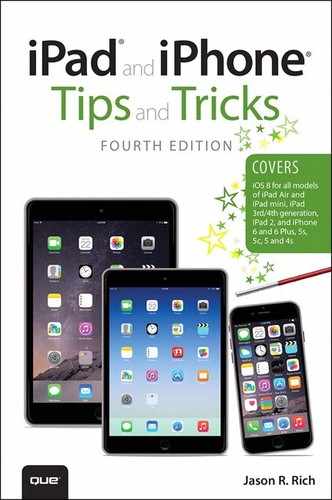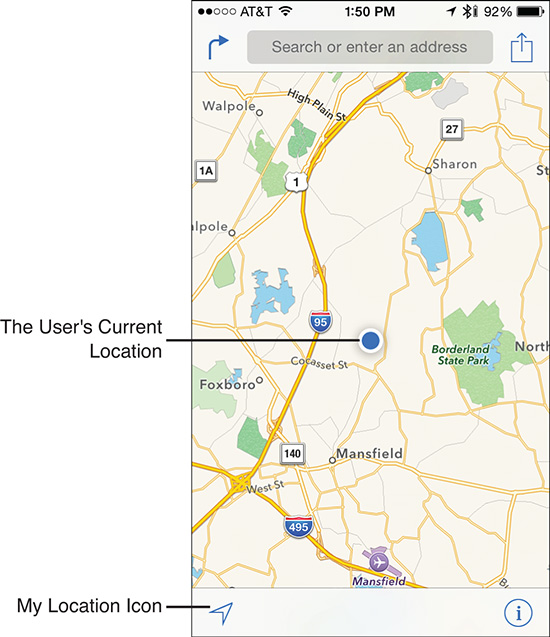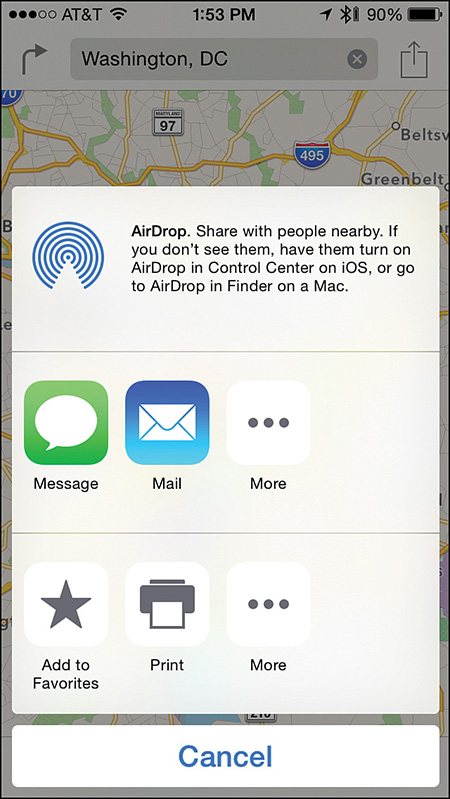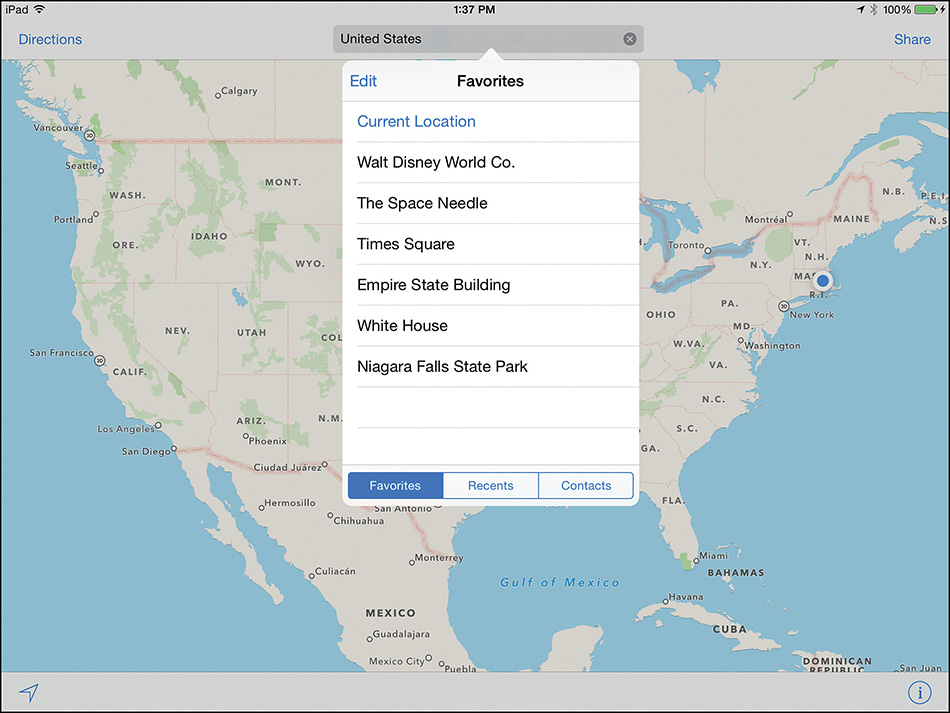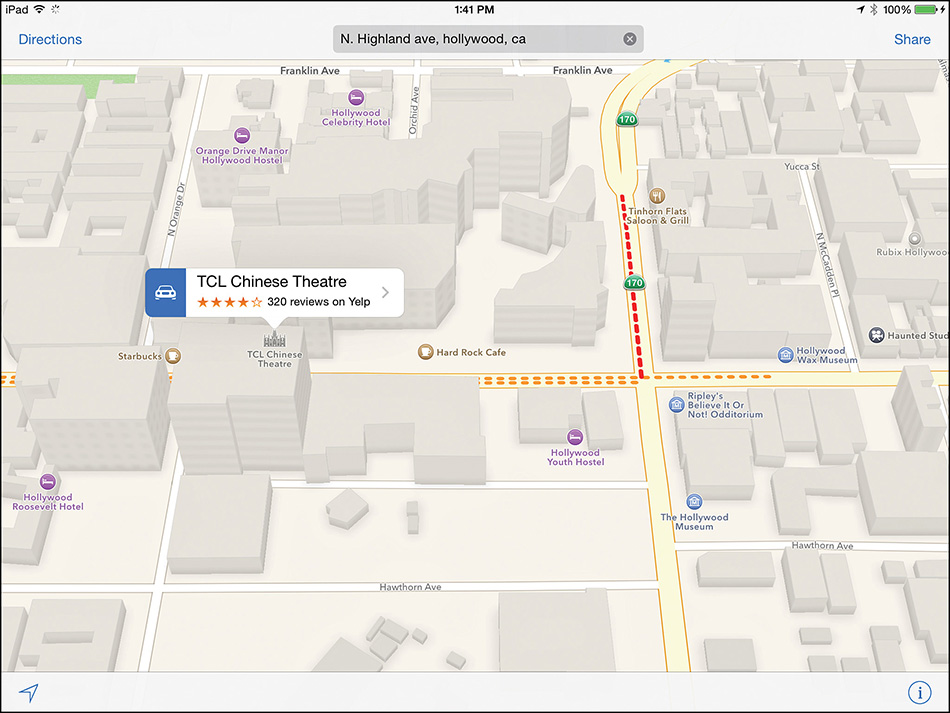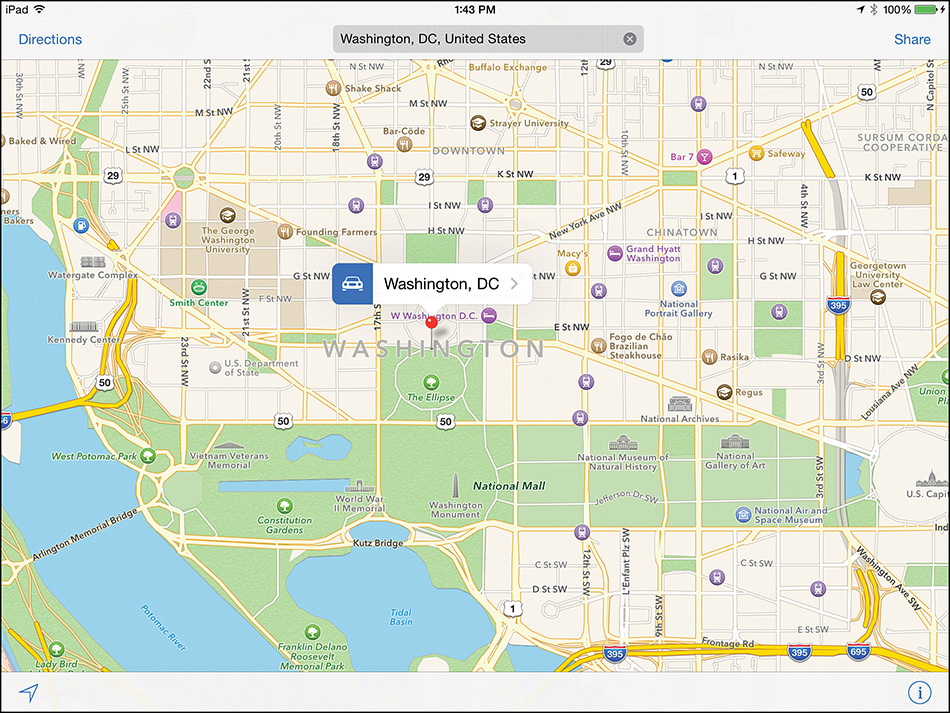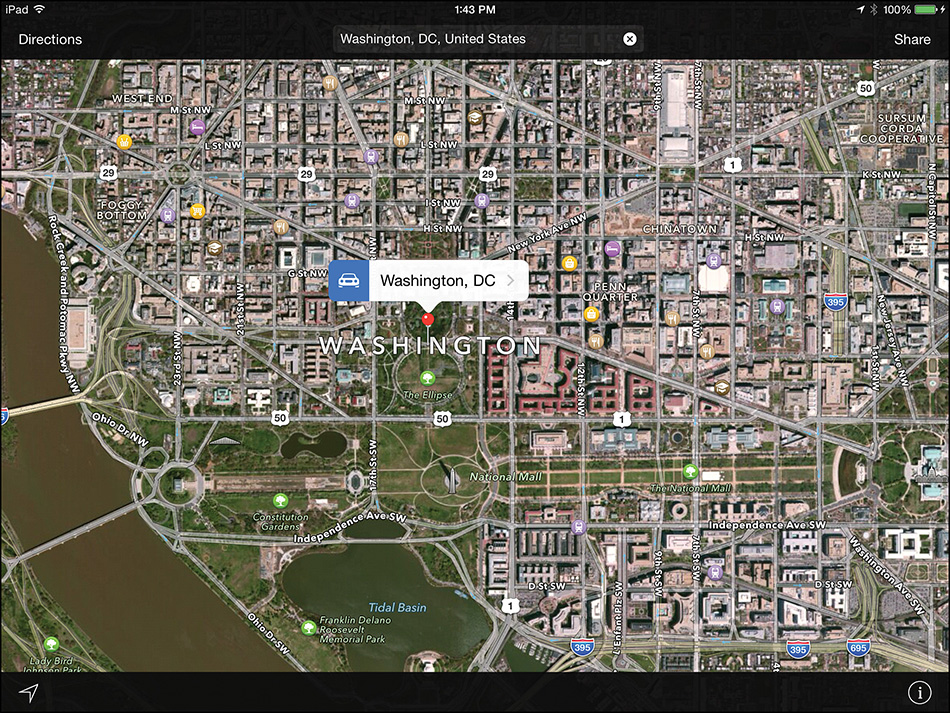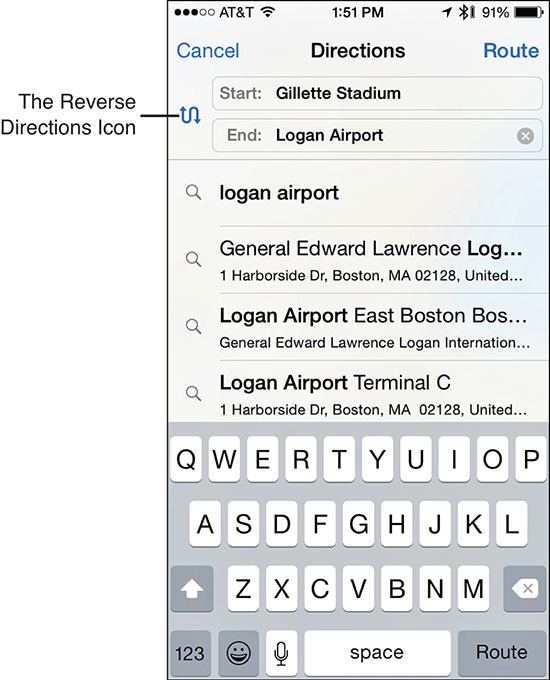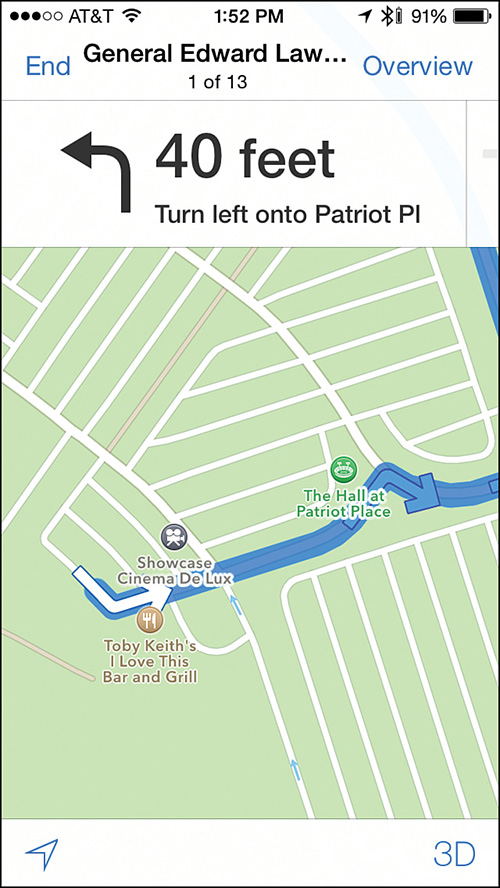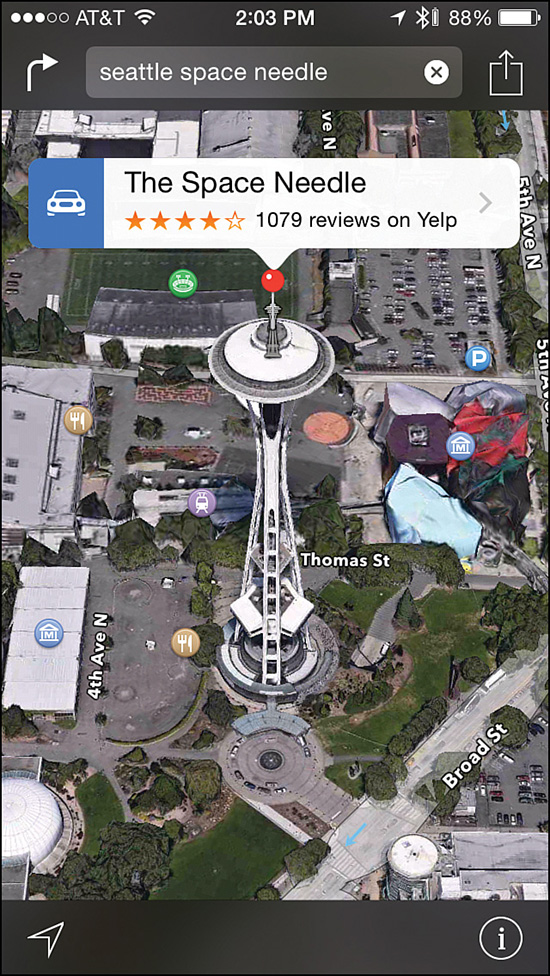6. Navigating with the Maps App
In This Chapter
![]() Use the Maps app to obtain turn-by-turn directions between two locations
Use the Maps app to obtain turn-by-turn directions between two locations
![]() Find and display any address, landmark, point-of-interest, or business on a map
Find and display any address, landmark, point-of-interest, or business on a map
![]() Discover how the Maps app works in conjunction with other iOS apps and features
Discover how the Maps app works in conjunction with other iOS apps and features
In its ongoing quest to provide a highly functional and extremely accurate navigation app, Apple has once again tweaked the Maps app with the release of iOS 8. For example, when you zoom in or out as you’re viewing a map on the screen, a graphical map scale is displayed in the upper-left corner to help you more accurately visually gauge distances.
The Maps app continues to require Internet access to function. Although the app works with a Wi-Fi connection, if you plan to use the app’s turn-by-turn directions feature, you must use a cellular data connection (which uses up some of your monthly wireless data allocation with each use) because you’ll be in motion and will quickly leave the wireless signal radius of any Wi-Fi hotspot.
That being said, a Wi-Fi connection can be used to pre-load driving directions prior to your departure. If your route changes, however, your iOS mobile device will not be able to help if it cannot connect to the Internet.
Using the Maps feature with Siri (which is very convenient) requires even more cellular data usage.
To get the most use out of the Maps app, the main Location Services feature in your iPhone or iPad (as well as Location Services for the Maps app) must be turned on. To do this, launch Settings, tap on the Privacy option, and then tap on Location Services. From the Location Services menu screen, turn on the virtual switch displayed near the top of the screen (associated with Location Services). Then, scroll down and tap on the Maps option. Be sure that the While Using option is selected.
![]() Caution
Caution
Just as when using any GPS device, do not rely 100 percent on the turn-by-turn directions you’re given. Pay attention as you’re driving and use common sense. If the Maps app tells you to drive down a one-way street or drive along a closed road, for example, ignore those directions and seek out an alternative route. Don’t become one of those people who literally drives into a lake or over a cliff because their GPS told them to. Yes, this does happen.
Get the Most from Using the Maps App’s Features
In addition to providing detailed maps, the Maps app is capable of displaying useful information with each map, including real-time, color-coded traffic conditions showing traffic jams and construction, which can be graphically overlaid onto maps. Plus, when you look up a business, restaurant, point of interest, or landmark, the Maps app seamlessly integrates with Yelp! to display detailed information about specific locations.
The Yelp! information screens for each location are interactive, so if you’re using an iPhone and tap on a phone number, you can initiate a call to that business or restaurant. Likewise, if you tap on a website URL (on either an iPhone or iPad), Safari launches and the applicable website automatically loads and displays.
![]() Tip
Tip
To enhance the capabilities of the Yelp! integration, download and install the optional (and free) Yelp! app from the App Store. Without the Yelp! app, when appropriate, the Maps app transfers you to the Yelp! website.
Yelp! is a crowd-sourced online database that contains more than 61 million reviews related to local businesses, stores, restaurants, hotels, tourist attractions, and points of interest. Reviews are created by everyday people who share their experiences, thoughts, and photos. Beyond user-provided reviews, Yelp! also offers details about many businesses and restaurants, often including menus.
Although Maps offers a lot of functionality packed into a standalone app, it’s also designed to work with many other apps. For example, as you’re viewing an entry in the Contacts app, when you tap on an address, the Maps app launches and displays that address on a map. You can then quickly obtain detailed directions to that location from your current location or from any address you select.
![]() Tip
Tip
Anytime you receive a text message or view a Calendar event that has an address included with it, iOS 8 automatically determines you’re looking at an address and turns it into an active link. Tap on this link to launch the Maps app and view the address or obtain directions to or from that address.
Plus, you can utilize many features built in to the Maps app using voice commands and requests thanks to Siri. For example, regardless of what you’re doing on the iPhone or iPad, it’s possible to activate Siri and say, “How do I get home from here?” or “Where is the closest gas station?” and then have the Maps app provide you with the directions and map you need.
![]() Tip
Tip
When you’re viewing a map using the Maps app, tap on the My Location icon (which looks like a northeast-pointing arrow) displayed near the bottom-left corner of the screen to pinpoint and display your exact location on the map. Your location is displayed using a pulsating blue dot (shown in Figure 6.1).
FIGURE 6.1 Tap on the My Location icon (near the lower-left corner of the screen) to pinpoint and display your exact location on a map using a pulsating blue dot.
Overview of the Maps App’s Screen
The main screen of the iOS 8 edition of the Maps app can now display a tiny compass in the upper-right corner of a map, as well as a map scale in the top-left corner of a map. The compass displays automatically when North isn’t toward the top of the screen. The map scale appears if you’re scrolling around a map using your finger or zooming in or out.
Displayed near the top-left corner of the screen is the Directions option. On the iPhone, this looks like a curved arrow that’s pointing to the right. On the iPad, the option actually says “Directions.”
If you’re relying on public transportation to get around a popular city, such as Manhattan, Boston, London, or Paris, download an app specifically designed for that public transportation system. To find one, tap the new Apps tab that appears when a route between two locations is provided, or use the Search option in the App Store. For example, enter the search phrase “London Tube Map” to find a variety of interactive apps to help you navigate your way around London’s subway/train system.
Use the Search field located at the top center of the Maps screen to find and map out any address. You can enter a complete address (house/building number, street, city, state) or provide less specific information, such as just a city, state, or country. Enter United States to see a map of the entire country. Enter California to view a map of the state.
You also have the option of entering Los Angeles, California, to view a more detailed map of the city, or you can enter a specific street address located within Los Angeles to view it on a detailed map that shows specific streets (and street names).
This Search field is also used to find businesses, restaurants, points of interest, landmarks, and tourist destinations. When the Maps app finds the location you’re looking for, you can zoom in or zoom out manually on that map to see more or less detail. Plus, you can change the Map view and switch between the Standard, Hybrid, Satellite, 3D, and/or Flyover views.
![]() Tip
Tip
In the Search field, enter the name of any contact that has an entry stored in the Contacts app to find and display an address for that contact. The Maps app searches the contents of your iOS device (including the Contacts app), followed by utilizing a web-based search, if applicable.
Anytime a specific location is identified on the map, such as results of a search, those results are displayed using a virtual red push-pin. Tap on a push-pin to view more details about that location and to access a separate Location screen (iPhone) or window (iPad).
Continuously displayed near the bottom-left corner of the main Maps screen is the My Location icon (it looks like a northeast-pointing arrow). At anytime a map is displayed, tap on this icon to locate and display (or update) your current location on the map. This feature is useful if you look up another destination and then want to quickly see where you’re located in comparison to that other location. However, when you’re using the Maps app for turn-by-turn directions, your iPhone/iPad keeps track of your location in real time and displays this on the map as you’re in motion.
As you’re viewing a map, tap on the Info icon that’s displayed at the bottom-right corner of the screen. A pop-up menu appears that gives you the option to instantly switch between a Standard, Hybrid, or Satellite map view. To do this, tap on the appropriate view that’s displayed at the top of this menu (shown in Figure 6.2).
FIGURE 6.2 Tap on the Info icon to reveal this pop-up menu. From here, you can customize how the current map is being displayed.
Additional options on this pop-up Info menu enable you to Drop A Pin, Show 3D Map, Report A Problem, and/or Show Traffic.
As you’re viewing a map, the main Maps app screen includes a Share icon (iPhone) or option (iPad) that’s displayed in the top-right corner of the screen. Tap on this Share icon/option to reveal a Share menu (shown in Figure 6.3), from which you can share location details with others, add the location to the Maps app’s Favorites list, or print the current map (using an AirPrint-compatible printer).
FIGURE 6.3 The Share menu that’s built in to the Maps app enables you to share your location with others via AirDrop, text message, or email.
![]() Tip
Tip
The newly redesigned Share menu includes an Add to Favorites button. Tap on this to save the currently viewed location as a Maps bookmark for later reference.
![]() What’s New
What’s New
To access your Favorites menu within the Maps app, tap on the Search field that’s located in the top center of the screen. Displayed immediately below the Recents heading is the Favorites option. Tap on this to reveal your list of manually saved Favorites locations. When this list is visible, tap any item to reopen the map of that location.
Displayed along the bottom of the Favorites menu are three tabs, labeled Favorites, Recents, and Contacts (shown in Figure 6.4). Tapping on the Favorites tab reveals an interactive list of manually saved Favorites locations that you have bookmarked. Tap on any listing view to reopen a map of that location. Tap on the Edit button to edit, delete, or reorder this list, or swipe your finger from right to left across a listing to delete it.
FIGURE 6.4 The Favorites list can display your saved Favorites locations, your search history, or your Contacts list.
Tap on the Recents tab to view a list of recently searched or viewed locations. To clear this list, tap on the Clear button displayed near the top-left corner of the screen.
When you tap on the Contacts tab, the All Contacts listing is displayed. This shows a comprehensive list of all entries stored in your Contacts database. All Contacts listings that are displayed in bold, black type have one or more addresses associated with them.
Whether you’re looking at the Favorites, Recents, or All Contacts list, tap on one of the listings to view that location on a map. It’s then possible to obtain detailed directions to or from that location.
View a Map from Multiple Perspectives
As you’re viewing a map on the screen, place one finger on the screen and drag it around to move the map around. To rotate the map, place two fingers (slightly separated) on the screen, and rotate your fingers clockwise or counterclockwise.
Use a reverse-pinch finger gesture to zoom in or a pinch finger gesture to zoom out. If you’re using the Satellite map view, you can zoom in very close, and then drag your finger around the map to take a bird’s-eye tour of the area that’s displayed in 3D. This feature works better with a high-speed Wi-Fi Internet connection. In some cases, instead of a 3D view, the Maps app offers a more detailed Flyover view.
The Updated Maps App’s Info Screen
The Info icon is displayed near the bottom-right corner of the main Maps screen. When you tap on this circular “i” icon, a window pops up that enables you to quickly switch between the Standard, Hybrid, or Satellite map view. Simply tap on one of the labeled tabs that are displayed near the top of this window (refer to Figure 6.2).
From the Info window, you can also drop a virtual pin on any location that’s displayed on the currently viewed map and show or hide color-coded traffic details on the map.
The Drop a Pin Option
When you tap on the Drop A Pin option, the full Maps screen returns. Tap anywhere on that map to place a virtual push-pin. The new push-pin is displayed in purple instead of red. After you place a push-pin, it’s possible to view detailed information about that particular location, including its exact address. You can then tap on the displayed Info icon to view a location menu that offers a handful of menu options, including Directions To Here, Directions From Here, Create New Contact, Add To Existing Contact, Remove Pin, Add Bookmark, or Report a Problem (shown in Figure 6.5).
FIGURE 6.5 Tap on the purple push-pin you place on a map to reveal a more detailed Info screen pertaining to that location. This window includes a menu as well.
![]() Tip
Tip
Tap on the Share icon to access the app’s Share menu to share the pinned location with others or add it to your Favorites list.
The Show/Hide Traffic Option
Regardless of which map view you’re looking at, you can have color-coded real-time traffic information superimposed on the map. This feature can help you avoid traffic jams and construction and enables you to seek an alternative route before you get stuck in the traffic.
![]() Note
Note
Mild traffic is showcased using yellow, while heavy traffic is depicted in red. When construction is being done on a roadway, separate construction icons (in yellow or red) are displayed on the map.
The Show Traffic feature works much better when you’re viewing a zoomed-in version of a map that shows a lot of street-level detail. Figure 6.6 shows heavy traffic conditions (a dashed red line) along N. Highland Ave. in Hollywood, California, near the famous TCL Chinese Theatre.
FIGURE 6.6 A red line along a roadway indicates heavy traffic when you have the Show Traffic feature turned on in the Maps app.
The Standard, Hybrid, and Satellite Tabs
Displayed along the top of the Maps Info window are the three map view command tabs: Standard, Hybrid, and Satellite. The Standard map view (shown in Figure 6.7) displays a traditional-looking, multicolored map on the screen. Street names and other important information are labeled and displayed on the map.
FIGURE 6.7 The Standard map view shows a traditional, multicolored map with street names and other points of interest listed on it.
The Satellite view uses high-resolution and extremely detailed satellite imagery to show maps from an overhead view, while the Hybrid map view (shown in Figure 6.8) showcases the same satellite imagery but overlays and displays street names and other important information, similar to the information you’d see using the Standard view.
FIGURE 6.8 The Hybrid map view shows street names and other details superimposed over a satellite image.
![]() Tip
Tip
Anytime you’re viewing a map, you can switch between map views. Then from the main Maps screen, tap on the My Location icon to display your exact location on the map. To switch between a 2D and 3D map view, tap on the Show 2D/3D Map option that’s displayed as part of the Info menu (refer to Figure 6.2).
![]() Tip
Tip
When you look up any business using the Maps app, if you then view the location of the business with the Satellite or Hybrid view, you can often determine the best place to park nearby. Consider dropping a pin on that location, and then using turn-by-turn directions to get you to that spot. There are also third-party apps, like Parker, that can help you find a parking spot or paid parking lot within a major city.
Obtain Turn-by-Turn Directions Between Two Locations
The turn-by-turn directions feature of the Maps app is not only easy to use, it’s also extremely useful. Begin using this feature from the main Maps app screen. Tap on the Directions icon located at the top-left corner of the screen.
The Start and End fields, as well as the reverse directions icon and recently displayed location results (if applicable), are shown within a pop-up window (see Figure 6.9).
FIGURE 6.9 Fill in the Start and End fields to obtain detailed, turn-by-turn directions between any two locations that you choose.
In the Start field, the default option is your current location; however, to change this, tap on the field and enter any starting address. Then tap on the End field and enter any ending address.
![]() Tip
Tip
Displayed below the Start and End field are recent locations you’ve utilized within the Maps app. Scroll up or down this list using your finger, or tap on any entry to use it as your Start or End location.
In the Start and End field, you can enter a contact entry’s name, a full address, a city and state, just a state, or just a country. You can use two-letter state abbreviations, and you don’t have to worry about using upper- and lowercase letters. For example, you can type “New York, NY,” “new york, ny,” or “New York, New York,” and get the same result. This goes for contacts or business names as well.
When the Start and End fields have been filled in, tap on the Route option that’s displayed near the top-right corner of the window. There’s also a Route button on the virtual keyboard.
A route overview map (shown in Figure 6.10) is displayed. The green push-pin represents your starting location and the red-push pin represents your ending location.
FIGURE 6.10 A sample route overview map shows your start and end location on one map, plus up to three possible driving routes to get there.
At the top of this route overview map are three command tabs, labeled Drive, Walk, and Apps. To obtain driving directions, tap on the Drive tab. For walking directions, tap on the Walk tab. If you want to use public transportation, tap on the Apps tab, and the Maps app refers you to related apps available from the App Store that can be used to better navigate around the area using public transportation.
If you select driving directions, the Maps app displays between one and three possible routes between the start and end locations.
The primary route is outlined on the route overview map with a dark blue line. One or two alternative routes may be outlined with light blue lines. Associated with each route is an approximate travel time.
![]() Note
Note
If the route requires you to take toll roads or a ferry service, for example, a warning message appears just below the Drive, Walk, and Apps tabs on the route overview screen.
![]() Tip
Tip
Turn on the Show Traffic option to display current traffic conditions along the three routes, and then choose the one with the least congestion or construction. Tap on any of the route lines to select your route. The route highlighted with the dark blue line is the default (recommended) route.
When you’re ready to begin your journey, tap on the Start option that’s displayed near the bottom center of the screen. You’re then given real-time turn-by-turn directions. Just like when using a standalone GPS device, a voice guides you through each turn, while also displaying related information on the main map screen (shown in Figure 6.11).
FIGURE 6.11 The Maps app shows detailed turn-by-turn directions on the map screen and speaks to you as you’re driving.
While the turn-by-turn directions are being displayed, the Standard map view is used. Your ETA, as well as how much time is left in your trip and the distance from your destination are displayed along the top the screen. At anytime, tap the Overview option to return to the route overview map, or tap the End option to exit out of the turn-by-turn directions feature and return to the main Maps screen. When available, you can also now tap on the 3D view option. Look for the 3D icon to be displayed in the bottom-right corner of the screen when applicable.
Follow the voice and onscreen prompts until you reach your destination. If you press the Home button, you can return to the Home screen and launch another app while the Maps feature is still running, and then return to the turn-by-turn directions by tapping on the blue bar that says Touch To Return To Navigation. It’s displayed near the top-right corner of the screen. This also works when you launch another app via the multitasking bar.
To view text-based directions to your destination, enter a Start and End location using the Directions feature of the Maps app, but before tapping Start to obtain the directions, tap on the Listing icon, which can be found just above the Info icon when viewing the route overview screen. Also, the List Steps option appears if you tap on the screen during the navigation process.
Use your finger to scroll up or down on this list, or tap on one of the individual directions to jump to the map that shows that step.
Look Up Contact Entries, Businesses, Restaurants, Landmarks, and Points of Interest
One of the other primary uses of the Maps app is to find and display addresses, contacts, businesses, points of interest, or landmarks on a map screen. To do this, from the main Maps screen, simply type what you’re looking for into the Search field. In Figure 6.12, Seattle Space Needle was entered into the search field.
FIGURE 6.12 The Seattle Space Needle in Seattle, Washington, is shown here using the hybrid and 3D map view.
If you’re looking for businesses or services in your immediate area, tap on the My Location icon first, so the iPhone or iPad pinpoints your location, and then enter what you’re searching for. No city or state needs to be entered. If you don’t tap on the My Location icon first, you must enter what you’re looking for, followed by the city, a comma, and the state, to find local search results. Otherwise, the Maps app defaults to the last search location.
If the business or service is considered a major point of interest, such as the Seattle Space Needle, Disney World, or O’Hare Airport, you do not need to include the city or state in the Search field.
Use the Interactive Location Screens to Find More Information
Once search results are displayed on the map in the form of virtual push-pins, tap on any push-pin to view an information banner for a location on a map. In Figure 6.13, a search for Apple Store locations in Los Angeles was performed and displayed on the map.
FIGURE 6.13 The results of a search for Apple Stores in the Los Angeles area appear as red virtual push-pins on this hybrid view map.
Tap on one push-pin, and then tap the left side of the information banner to obtain “quick” turn-by-turn directions from your current location. Or, tap on the Info icon on the right side of the listing to view an interactive Location screen.
A separate and informative Location screen (shown in Figure 6.14) displays details about that search result using details from the Maps app, the Internet, and from Yelp!. This information includes the phone number, address, website URL, and other information for that search result. The information displayed depends on whether it’s a business, restaurant, point of interest, or tourist attraction.
FIGURE 6.14 A detailed Location screen combines location information with details about that location obtained from Yelp!. Information about the Apple Store at The Grove in Los Angeles is shown here.
![]() Tip
Tip
When looking at multiple search results on a map (refer to Figure 6.13), tap on the List Results option to view a text-based interactive listing of the search results.
As you scroll down on the Location screen, you’ll see a Directions To Here and Directions From Here option. Tap on either of these to obtain directions to or from your current location to the address listed on the screen.
Tap on the More Info On Yelp! option to launch the Yelp! app or visit the Yelp! website to view more detailed information about that location.
Create New Contact, Add To Existing Contact, and Report A Problem options are also available by scrolling down in the Location window.
![]() Tip
Tip
Yelp! relies on individual users like you for its reviews, photos, and information. From the location information screen within Maps, it’s possible to add your own photo related to a location, Check-In at that location, or Write a Review of that location (which might be a restaurant, business, or point of interest).
Displayed next to the Reviews From Yelp option is a See More> option. Tap on it to view all the individual reviews that others have published on Yelp! that are related to the selected location. For example, you can use these reviews to help you decide where to dine or determine which mechanic to use at a local service station if your car needs repair.
Another potentially useful feature offered within each location window is a Popular Apps Nearby listing. This showcases a handful of optional third-party apps that are relevant to that specific area. From this listing, you might find apps from local stores, malls, tourist attractions, or media outlets, for example.
![]() Tip
Tip
If you look up information about a restaurant, the Location screen features Yelp!-related information, including the type of food served, the menu price range (using dollar sign symbols), the hours of operation, and potentially a website link that enables you to view the restaurant’s menu. You can also determine whether the restaurant delivers or accepts reservations.
If reservations are accepted, use the optional Open Table app to make reservations online. Activate Siri and say, “Make a reservation for [insert number of people] for [insert day and time],” or initiate a call from an iPhone to the restaurant by tapping on the phone number field.
The Maps App’s Flyover View
In the iOS 8 edition of the Maps app, the 3D map view and the Flyover view that were featured in iOS 7 have been integrated together. The Flyover map view is offered for many major cities, although it doesn’t really serve a navigation purpose. This feature, however, can be used to help you get acquainted with the layout of a city and enable you to take a virtual tour of its skyline from your iPhone or iPad.
When it’s available, the 3D option that’s normally displayed as a map view option is replaced with the Flyover icon (which looks like a building). Tap on it to switch to a stunning Flyover map view.
Maps Quick Tips
![]() To customize several settings related to the Maps app, launch Settings and tap on the Maps option. From the Maps menu screen, it’s possible to decide whether to show distances in miles or kilometers, plus automatically have the iPhone/iPad translate map labels into English.
To customize several settings related to the Maps app, launch Settings and tap on the Maps option. From the Maps menu screen, it’s possible to decide whether to show distances in miles or kilometers, plus automatically have the iPhone/iPad translate map labels into English.
![]() As you’re viewing a map, it’s almost always possible to zoom in or out using either a reverse-pinch or pinch figure gesture or a double-tap on an area of the map.
As you’re viewing a map, it’s almost always possible to zoom in or out using either a reverse-pinch or pinch figure gesture or a double-tap on an area of the map.
![]() After tapping the Directions option to obtain directions between two addresses, a Reverse icon is displayed to the immediate left of the Start and End. Tap it to switch the addresses you have in the Start and End fields to obtain reverse directions.
After tapping the Directions option to obtain directions between two addresses, a Reverse icon is displayed to the immediate left of the Start and End. Tap it to switch the addresses you have in the Start and End fields to obtain reverse directions.
![]() As the Maps app is giving you real-time turn-by-turn directions, tap on the Overview option to switch back to the route overview map. Or tap on the screen to view the List Steps option and see a text-based turn-by-turn directions listing. Tap the Resume option to exit out of this view.
As the Maps app is giving you real-time turn-by-turn directions, tap on the Overview option to switch back to the route overview map. Or tap on the screen to view the List Steps option and see a text-based turn-by-turn directions listing. Tap the Resume option to exit out of this view.
![]() When using your iPhone or iPad with the Maps app, the iOS mobile device accesses the Internet extensively. This drains the device’s battery faster. If you use this feature from your car often, consider investing in a car charger that plugs into your car’s 12-volt jack. This way, your iPhone/iPad’s battery remains charged (and can recharge) while it’s being used.
When using your iPhone or iPad with the Maps app, the iOS mobile device accesses the Internet extensively. This drains the device’s battery faster. If you use this feature from your car often, consider investing in a car charger that plugs into your car’s 12-volt jack. This way, your iPhone/iPad’s battery remains charged (and can recharge) while it’s being used.
![]() Using the Maps app for turn-by-turn directions via a cellular data Internet connection requires a significant amount of wireless data usage. Using this feature can quickly deplete your monthly wireless data allocation unless you’re subscribed to an unlimited wireless service plan. Also, if you’re using international roaming to access the Internet from abroad, using Maps with a cellular data connection can get very expensive.
Using the Maps app for turn-by-turn directions via a cellular data Internet connection requires a significant amount of wireless data usage. Using this feature can quickly deplete your monthly wireless data allocation unless you’re subscribed to an unlimited wireless service plan. Also, if you’re using international roaming to access the Internet from abroad, using Maps with a cellular data connection can get very expensive.
![]() When viewing a map, a compass appears near the upper-right corner of the screen when the map is not oriented with North at the top of the screen. When you tap on the My Location icon, the Map is displayed using a north-facing orientation. If you double-tap on the My Location icon, the map orientates itself in the direction you’re traveling.
When viewing a map, a compass appears near the upper-right corner of the screen when the map is not oriented with North at the top of the screen. When you tap on the My Location icon, the Map is displayed using a north-facing orientation. If you double-tap on the My Location icon, the map orientates itself in the direction you’re traveling.
![]() Use Siri to quickly find addresses in your Contacts database or to locate a business or point of interest, and then plug in that information to the Maps app without any manual data entry required.
Use Siri to quickly find addresses in your Contacts database or to locate a business or point of interest, and then plug in that information to the Maps app without any manual data entry required.
![]() When using almost any other app on your iPhone or iPad, anytime an address is listed, if that address is underlined (meaning that iOS 8 has converted it into a hyperlink), you can tap on that address to launch the Maps app and view the location on a detailed map. At that point, you can use any of the Maps app’s features to get directions to that location or learn more about that location.
When using almost any other app on your iPhone or iPad, anytime an address is listed, if that address is underlined (meaning that iOS 8 has converted it into a hyperlink), you can tap on that address to launch the Maps app and view the location on a detailed map. At that point, you can use any of the Maps app’s features to get directions to that location or learn more about that location.
![]() What’s New
What’s New
If you are a business operator who wants to customize your company’s listing in the Maps app to attract new customers or allow Maps users to find and learn more about your business, visit https://mapsconnect.apple.com. Sign in to Apple’s Maps Connect website using your Apple ID, and follow the onscreen prompts up create or update a business listing. In a week or so, the information will be verified and become accessible to anyone using the Maps app from their iOS mobile device or Mac.
